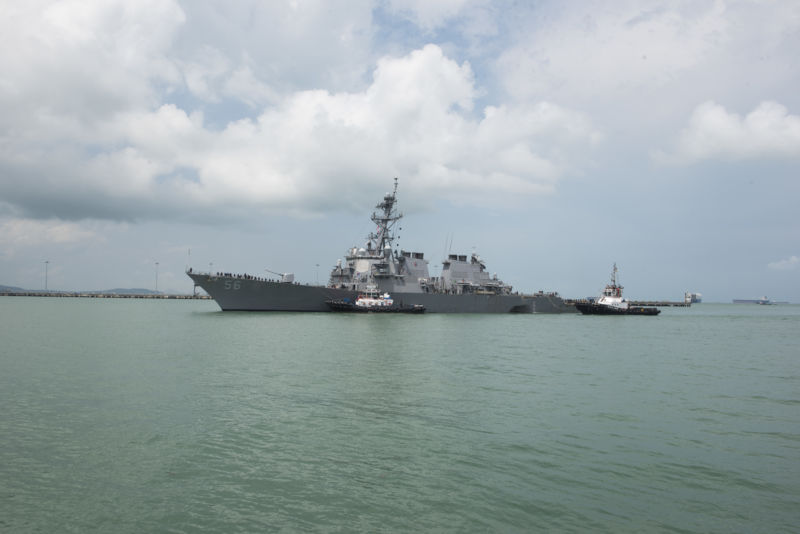
On November 1, the US Navy issued its report on the collisions of the USS Fitzgerald and USS John S. McCain this summer. The Navy's investigation found that both collisions were avoidable accidents. And in the case of the USS McCain, the accident was in part caused by an error made in switching which control console on the ship's bridge had steering control. While the report lays the blame on training, the user interface for the bridge's central navigation control systems certainly played a role.
According to the report, at 5:19am local time, the commanding officer of the McCain, Commander Alfredo J. Sanchez, "noticed the Helmsman (the watchstander steering the ship) having difficulty maintaining course while also adjusting the throttles for speed control." Sanchez ordered the watch team to split the responsibilities for steering and speed control, shifting control of the throttle to another watchstander's station—the lee helm, immediately to the right (starboard) of the Helmsman's position at the Ship’s Control Console. While the Ship's Control Console has a wheel for manual steering, both steering and throttle can be controlled with trackballs, with the adjustments showing up on the screens for each station.
However, instead of switching just throttle control to the Lee Helm station, the Helmsman accidentally switched all control to the Lee Helm station. When that happened, the ship's rudder automatically moved to its default position (amidships, or on center line of the ship). The helmsman had been steering slightly to the right to keep the ship on course in the currents of the Singapore Strait, but the adjustment meant the ship started drifting off course.
-
The bridge layout on the McCain, with watchstations labeled. The ship should have had its full "sea and anchor" detail on watch.
-
The Ship Control Console of the McCain, with helm (at left) and lee helm (at right) stations. Both have trackballs to enter commands into the console through control screens.
-
As the McCain watch team scrambled to figure out what was going on, the ship overtook and steered across the bow of the Alnic MC.
"This unplanned shift caused confusion in the watch team, and inadvertently led to steering control transferring to the Lee Helm Station without the knowledge of the watch team," the report found. "The CO had only ordered speed control shifted. Because he did not know that steering had been transferred to the Lee Helm, the Helmsman perceived a loss of steering."
At this point, everyone on the bridge thought there had been a loss of steering. In the commotion that ensued, the commanding officer and bridge crew lost track of what was going on around them. Sanchez ordered the engines slowed, but the lee helmsman only slowed the port (left) throttle, because the throttle controls on-screen were not "ganged" (linked) at the time as the result of the switch-over of control. The ship continued to turn uncontrolled to port—putting the ship on a collision course with the Liberian-flagged chemical carrier Alnic MC.
Three minutes later, steering control was reestablished by control from the McCain's Aft Steering station, located near the ship's rudders. The Lee Helmsman corrected the throttle problem, but the recovery didn't come in time. "In the course of 3 minutes of confusion in a high traffic sea channel, the McCain was in irreversible trouble. These actions were too late, and at approximately [5:24 AM local time] JOHN S MCCAIN crossed in front of ALNIC’s bow and collided," the report states.
The report found that the McCain did not have the right type of watch on duty for navigation in congested waters and that watchstanders' training was insufficient. But there was never a warning signal from the Alnic of impending collision or a change of course by the merchant in an effort to avoid the collision. "Despite their close proximity, neither JOHN S MCCAIN nor ALNIC sounded the five short blasts of whistle required by the International Rules of the Nautical Road for warning one another of danger," investigators found, "and neither attempted to make contact through Bridge to Bridge communications."
reader comments
123